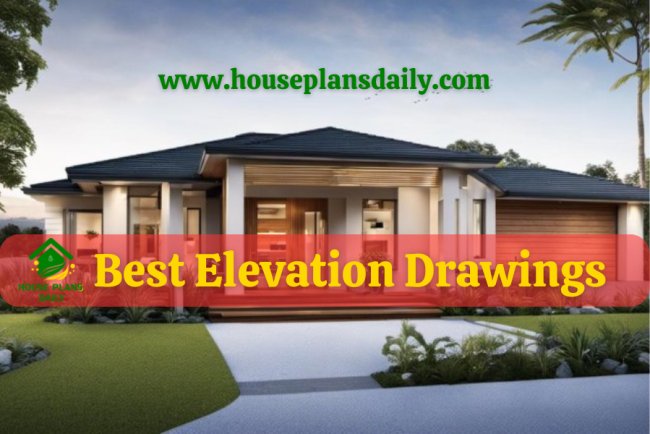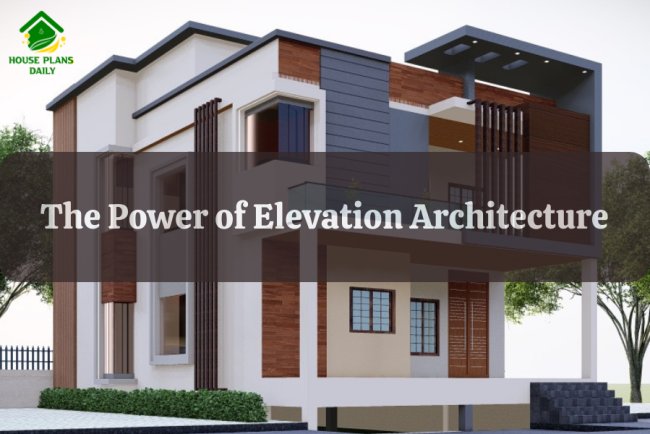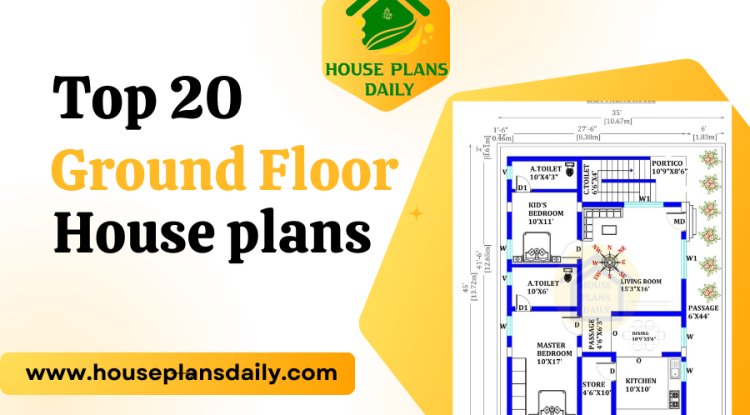Benefits of 3D Elevation in House Plans
Welcome to the future of home design. In this article, we will explore the game-changing benefits of 3D elevation in house plans.
Benefits of 3D Elevation in House Plans
Welcome to the future of home design. In this article, we will explore the game-changing benefits of 3D elevation in house plans. With advancements in technology, architects and homeowners now have access to an innovative tool that revolutionizes the way we envision and build our homes.
By incorporating 3D elevation into house plans, designers are able to create highly accurate and realistic representations of the finished product. This not only allows homeowners to visualize their dream home before construction begins but also enables architects to make informed decisions about design elements such as rooflines, window placements, and exterior materials.
But the advantages of 3D elevation go beyond aesthetics. With this technology, architects can identify potential design flaws and structural issues early in the planning phase, saving time and money in the long run. Additionally, 3D elevation provides a valuable marketing tool, allowing builders to showcase their projects in a visually stunning and captivating manner.
Say goodbye to flat, 2D plans and embrace the future of home design. Let us dive into the world of 3D elevation and discover the incredible benefits it brings to the table.

House Plan Design 3d Elevation
Improved visualization and realistic representation
One of the key benefits of incorporating 3D elevation in house plans is the improved visualization and realistic representation it offers. With traditional 2D plans, it can be challenging for homeowners to truly understand the spatial layout and how different design elements will come together. However, with 3D elevation, architects can create detailed, lifelike renderings that provide a clear and accurate depiction of the final product.
These 3D models allow homeowners to visualize their dream homes from various angles, both inside and out. They can see how natural light will filter through the windows, how the exterior materials will look in different lighting conditions, and how different design choices will impact the overall aesthetic. This level of visualization greatly enhances the decision-making process, as homeowners can make more informed choices about the design elements they want to incorporate into their homes.
Enhanced communication between homeowners and architects
Effective communication between homeowners and architects is crucial to the success of any home design project. However, translating design ideas from paper to reality can sometimes be challenging. This is where 3D elevation can bridge the gap and facilitate better communication.
With 3D elevation, architects can present their design concepts to homeowners in a more tangible and relatable way. Homeowners can easily grasp the design intent and provide feedback or make changes early on in the process. This streamlines the communication process and ensures that both parties are on the same page, minimizing misunderstandings or discrepancies in the final design.
Furthermore, 3D elevation allows architects to showcase their expertise and creativity in a more impactful manner. They can present multiple design options to homeowners and demonstrate how each option will look in the context of their specific project. This level of visual communication fosters a collaborative environment, where homeowners feel involved and invested in the design process.
Time and cost savings in the design process
Traditional design processes often involve multiple iterations and revisions, which can be time-consuming and costly. However, by incorporating 3D elevation into house plans, architects can streamline the design process and save valuable time and resources.
With 3D elevation, architects can identify potential design flaws or conflicts early on in the planning phase. They can evaluate different design options and make informed decisions about the most efficient and cost-effective approach. This proactive approach eliminates the need for costly redesigns or modifications during the construction phase.
Additionally, 3D elevation enables architects to accurately estimate material quantities, reducing the risk of over or under-ordering materials. This level of precision helps to minimize wastage and optimize the budget, ultimately saving homeowners and builders money.
Increased accuracy and reduced errors in construction
Accurate and error-free construction is essential for the successful completion of any home design project. With 3D elevation, architects can ensure that the construction process is based on highly accurate and detailed plans, reducing the likelihood of errors or misinterpretations.
By providing builders with comprehensive 3D elevation plans, architects can convey their design intent with precision. Builders can refer to these plans during the construction process, ensuring that every detail is executed correctly. This level of accuracy minimizes the risk of costly construction mistakes and ensures that the final product closely aligns with the original design vision.
Furthermore, 3D elevation allows architects to identify potential clashes or conflicts between different building systems, such as plumbing, electrical, or HVAC. By addressing these issues in the planning phase, architects can prevent costly and time-consuming rework during construction.
Customization options and flexibility in design
Every homeowner has unique preferences and requirements when it comes to their dream home. 3D elevation provides architects with the flexibility to customize designs and cater to the specific needs of each homeowner.
With 3D elevation, architects can easily make modifications to the design in real-time, allowing homeowners to visualize different design options and choose the one that best suits their lifestyle. Whether it's adjusting room sizes, changing the layout, or experimenting with different finishes, 3D elevation empowers homeowners to actively participate in the design process and create a home that truly reflects their vision.
This flexibility also extends to future modifications or renovations. By having a detailed 3D elevation plan, homeowners can easily explore different renovation options and visualize how these changes will impact the overall design. This level of flexibility ensures that homes can adapt and evolve with the changing needs of homeowners over time.

House Plan drawing
Showcasing the potential of the property to buyers or investors
For builders and developers, 3D elevation is a powerful marketing tool that can showcase the potential of a property to potential buyers or investors. With stunning and realistic 3D renderings, builders can create compelling marketing materials that capture the imagination of their target audience.
These visual representations allow potential buyers or investors to see the property's exterior design, landscaping, and overall aesthetic before it is even built. This level of visual appeal can significantly influence their decision-making process and generate more interest in the project.
Additionally, 3D elevation can be used to create virtual tours or walkthroughs, providing a realistic and immersive experience for potential buyers. They can explore the property from the comfort of their own homes, getting a sense of the flow, spatial layout, and overall ambiance. This level of engagement can help potential buyers or investors feel more confident in their decision to invest in the property.
Successful case studies and examples of using 3D elevation in house plans
To truly understand the impact of 3D elevation in house plans, let's explore some successful case studies and examples where this technology has been utilized effectively.
Case Study 1: Modern Urban Residence
In this case study, a renowned architect used 3D elevation to design a modern urban residence. By incorporating 3D elevation into the house plans, the architect was able to showcase the sleek and contemporary design elements, such as floor-to-ceiling windows, clean lines, and innovative use of materials. The 3D renderings allowed the homeowners to visualize their future home and make informed decisions about design choices. The end result was a stunning residence that perfectly captured their vision.
Case Study 2: Sustainable Eco-friendly Home
In another case study, an architect used 3D elevation to design a sustainable and eco-friendly home. The 3D renderings highlighted the integration of renewable energy systems, green roofs, and energy-efficient materials. Potential buyers were able to see how these sustainable features seamlessly blended with the overall design, creating a harmonious and environmentally conscious living space. The use of 3D elevation played a significant role in attracting environmentally conscious buyers and positioning the property as a sustainable investment.
Case Study 3: Luxury Resort Villa
In this case study, a luxury resort villa was designed using 3D elevation. The intricate details of the villa, including the luxurious interiors, expansive outdoor spaces, and breathtaking views, were brought to life through stunning 3D renderings. These visuals allowed potential buyers to experience the grandeur and exclusivity of the property, generating a high level of interest and demand. The use of 3D elevation proved to be a valuable marketing tool in selling the luxury resort villa.
Enhanced communication between homeowners and architects
As we conclude our exploration of the benefits of 3D elevation in house plans, it is clear that this technology is revolutionizing the way we envision and build our homes. From improved visualization and enhanced communication to time and cost savings, increased accuracy, customization options, and powerful marketing capabilities, 3D elevation offers a multitude of advantages for architects, homeowners, builders, and investors alike.
By embracing 3D elevation in the design process, we can create homes that are not only visually stunning but also perfectly tailored to the unique preferences and needs of homeowners. The future of home design is here, and it is time to embrace the incredible benefits that 3D elevation brings to the table.
So, say goodbye to flat, 2D plans and step into a world of limitless possibilities with 3D elevation. Your dream home awaits, and with this innovative technology, you can bring it to life like never before.

modern home design ideas
Time and cost savings in the design process
In traditional home design, homeowners often struggle to fully grasp the vision and intent of the architect. Flat, 2D plans can be difficult to interpret, leaving homeowners uncertain about the final outcome of their project. This lack of clarity can lead to miscommunication, frustration, and costly changes during construction.
With 3D elevation, this problem is solved. Homeowners can now see a realistic representation of their future home, complete with all the intricate details. This enables them to provide valuable feedback and make informed decisions early in the design process. Architects can easily incorporate changes and adjustments, ensuring that the final design meets the client's expectations.
Not only does 3D elevation enhance communication between homeowners and architects, but it also fosters collaboration. By actively involving homeowners in the design process, architects can create a sense of ownership and ensure that the final product truly reflects the client's vision. This collaborative approach leads to greater satisfaction and a smoother construction process.
Increased accuracy and reduced errors in construction
Designing a home is a complex and time-consuming process. Traditionally, architects would spend countless hours creating 2D plans, only to find out later that adjustments need to be made. This iterative process can be frustrating and lead to delays in the construction timeline.
With 3D elevation, architects can significantly reduce the time spent on revisions and modifications. The ability to create a realistic representation of the home allows architects to identify potential design flaws and make adjustments early on. This not only saves time but also reduces the need for costly changes during construction.
Furthermore, 3D elevation streamlines the decision-making process. Homeowners can now see how different design elements, such as roof styles or window placements, will look on their home. This visual clarity eliminates guesswork and allows for quicker decision-making, ultimately speeding up the design process.
In addition to saving time, 3D elevation also offers cost savings. By identifying design flaws and structural issues early on, architects can make necessary adjustments before construction begins. This proactive approach prevents costly rework and ensures a smooth construction process, saving both time and money.
Customization options and flexibility in design
One of the biggest challenges in the construction industry is ensuring that the final product matches the initial vision. Misinterpretation of 2D plans can lead to errors and inconsistencies during construction, resulting in costly mistakes.
With 3D elevation, the accuracy of the construction process is greatly enhanced. Builders can now refer to a highly detailed and realistic representation of the home, ensuring that every aspect is built according to the intended design. This eliminates guesswork and reduces the likelihood of errors.
Furthermore, 3D elevation allows for precise measurement and placement of building elements. Architects can accurately determine the size and location of windows, doors, and other architectural features. This level of precision ensures that the final product is not only visually stunning but also structurally sound.
By incorporating 3D elevation into the construction process, builders can minimize errors and rework, ultimately saving time and money. The increased accuracy also leads to a higher quality finished product, resulting in greater customer satisfaction.

house plan with 3d elevation
Showcasing the potential of the property to buyers or investors
Every homeowner has unique preferences and requirements when it comes to the design of their dream home. Traditional 2D plans often limit the level of customization and flexibility available to homeowners.
With 3D elevation, homeowners have the opportunity to fully customize and personalize their home design. They can visualize different design options, experiment with various materials, and explore different architectural styles. This level of customization allows homeowners to create a home that perfectly reflects their individual taste and lifestyle.
Furthermore, 3D elevation enables architects to easily incorporate changes and modifications. If a homeowner decides to add an extra room or alter the layout of a space, the 3D model can be quickly adjusted to reflect these changes. This flexibility in design ensures that the final product meets the client's evolving needs and preferences.
Successful case studies and examples of using 3D elevation in house plans
For builders and developers, 3D elevation offers a powerful marketing tool. In today's competitive real estate market, it is crucial to stand out and capture the attention of potential buyers or investors.
With 3D elevation, builders can showcase the full potential of a property in a visually stunning and captivating manner. A 3D model allows buyers to see the property from different angles and perspectives, giving them a clear understanding of its layout and design. This immersive experience helps buyers envision themselves living in the space, increasing their emotional connection to the property.
Furthermore, 3D elevation can be used to create virtual tours or interactive presentations. Buyers can explore the property virtually, experiencing its unique features and ambiance. This interactive approach not only captivates potential buyers but also allows developers to highlight the key selling points of the property.
By incorporating 3D elevation into their marketing strategies, builders and developers can attract more interest and generate higher sales or investment opportunities. The ability to showcase the potential of a property in a visually captivating manner sets them apart from the competition and leaves a lasting impression on potential buyers or investors.
Conclusion: Embracing the future of home design with 3D elevation
To truly understand the transformative power of 3D elevation in house plans, let's explore some successful case studies and examples.
One such example is the renovation of a historic home in a bustling city. The homeowners wanted to preserve the historical charm of the property while incorporating modern design elements. By using 3D elevation, the architects were able to create a virtual model that accurately represented the final outcome. This allowed the homeowners to make informed decisions about the design, ensuring that the renovation met their expectations. The end result was a seamless blend of old-world charm and contemporary design.
Another example is a luxury beachfront property. The developers wanted to showcase the breathtaking ocean views from every room in the house. With 3D elevation, they were able to create a virtual tour that highlighted the panoramic views and the seamless flow of indoor and outdoor spaces. This immersive experience helped potential buyers envision themselves living in this dream coastal retreat, resulting in multiple offers and a quick sale.
These case studies demonstrate the versatility and effectiveness of 3D elevation in different types of projects. Whether it's a historic renovation or a luxury property, 3D elevation enhances the design process, improves communication, and ultimately leads to stunning and successful outcomes.





























